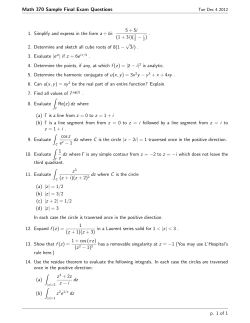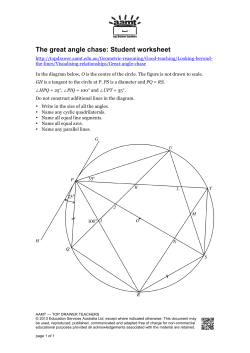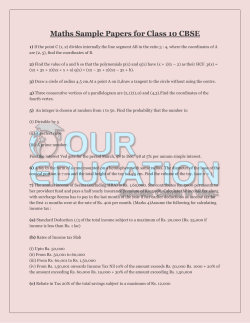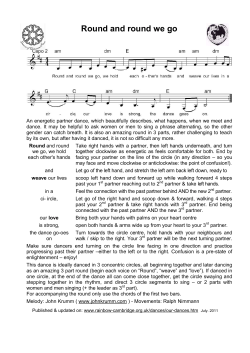
MATH 2030, Spring 2015 Midterm 1 Solutions
MATH 2030, Spring 2015 Midterm 1 Solutions 1. For the differential equation y 0 = y 2 − 3y + 2: a) Find all equilibrium solutions b) Sketch the graphs of various types of solutions c) Find the limit limt→+∞ y(t) depending on the initial condition y(0) = y0 d) Solve the equation explicitly Solutions: We have y 0 = (y − 1)(y − 2). For an equilibrium solution y = const we have y 0 = 0, so y = 1 or y = 2. The derivative y 0 is positive for y > 2 and y < 1, and negative for 1 < x < 2, so y(x) is decreasing for 1 < y < 2 and increasing for y > 2 or y < 1. 4 3 2 1 −2 −1 1 2 −1 We have +∞ if y0 > 2, lim y(t) = 2 if y0 = 2, t→+∞ 1 if y0 < 2. 1 3 To solve the equation explicitly, remark that it is separable: Z Z dy 0 = dt. y = (y − 1)(y − 2) ⇒ (y − 1)(y − 2) To compute the integral in the left hand side, we use partial fractions: Z y − 2 1 dy 1 1 . = − , = ln |y−2|−ln |y−1| = ln (y − 1)(y − 2) y−2 y−1 (y − 1)(y − 2) y − 1 Therefore y − 2 = t + C, y − 2 = ±et+C = Aet , y − 2 = (y − 1)Aet = Aet y − Aet , ln y − 1 y−1 so y(1 − Aet ) = 2 − Aet ⇒ y(t) = 2 − Aet . 1 − Aet 2. Solve the differential equations: a) xy 0 = 2y + 1 Z Solution: This is a separable equation: Z 1 dx dy = ⇒ ln |2y + 1| = ln |x| + C, ln |2y + 1| = 2 ln |x| + 2C, 2y + 1 x 2 2y + 1 = ±e2 ln |x|+2C = Ax2 ⇒ y(x) = Ax2 − 1 . 2 b) (1 + t2 )y 0 + 2ty = 1 Solution: This is an exact equation: ((1 + t2 )y)0 = 1, (1 + t2 )y = t + C, y(t) = t+C . t2 + 1 3. Find all values of the parameter a such that the differential equation (x + y + 1) + (ax + y + 2)y 0 = 0. is exact. Solve the equation for these values of a. Solution: We have M = x + y + 1, N = ax + y + 2, so My = 1, Nx = a, and the equation is exact if a = 1. 2 In this case, we need to find a function F such that Fx = x + y + 1, Fy = x + y + 2. 2 From the first equation we have F = x2 + xy + x + h(y), so Fy = x + h0 (y) = 2 x + y + 2, and we can pick h(y) = y2 + 2y. Therefore: y2 x2 F (x, y) = + xy + 2y + + x = C. 2 2 This is a quadratic equation for y: y2 x2 + (x + 2)y + ( + x − C) = 0, 2 2 so r y(x) = −x−2± √ 1 x2 (x + 2)2 − 4 ( + x − C) = −x−2± x2 + 4x + 4 − x2 − 2x + 2C = 2 2 √ −x − 2 ± 2x + 4 + 2C. 4. Solve the initial value problems: √ a) y 0 = y, y(0) = 1 Solution: This is a separable equation: Z Z dy √ √ = dx, 2 y = x + C. y Since y(0) = 1, we have C = 2, so x 2 √ 2 y = x + 2, y(x) = +1 . 2 b) ty 0 + 3y = 2t2 + 1, y(1) = 1 Solution: This is a linear equation: 3 1 y 0 + y = 2t + . t t Let us find an integrating factor: 3 µ (t) = µ(t), t 0 Z 3 dµ = µ Z 3 dt, t ln |µ| = 3 ln |t| + C ⇒ µ(t) = ±e3 ln |t|+C = At3 . We can pick A = 1 and get: (t3 y(t))0 = t3 y 0 (t) + 3t2 y(t) = 2t4 + t2 , 2t5 t3 + + C, 5 3 2 2t 1 C y(t) = + + 3. 5 3 t t3 y(t) = Since y(1) = 1, we have C =1− and 4 2 1 − = , 5 3 15 4 2t2 1 + + . y(t) = 5 3 15t3 5. Find all values of the parameter r such that all solutions of the differential equation y 0 = ry + r2 t are bounded for t > 0. Solution: Let us find a general solution first. This is a linear equation: y − ry = r2 t, and the integrating factor equals µ = e−rt , so Z −rt 0 2 −rt −rt 2 (e y) = r e t, e y(t) = r e−rt tdt = 0 Z −r td(e −rt ) = −rte −rt Z +r e−rt dt = −rte−rt − e−rt + C, y(t) = −rt − 1 + Cert . For r > 0 and C 6= 0 the term Cert tends to infinity much faster then rt, so y(t) → ∞. For r < 0 we have Cert → 0, but rt → ∞, so y(t) → ∞. Finally, for r = 0 we get y(t) = C − 1. Therefore the solutions are bounded if and only if r = 0. 6*. Show that the solution of the initial value problem y 0 = x2 + y 2 − 1, y(0) = 0.5 4 has an inflection point. Hint: sketch the graph of this solution first Solution: Note that x2 + y 2 − 1 is negative inside the unit circle and positive outside the unit circle. Therefore the solution is increasing outside the circle and has both a local minimum and a local maximum on a circle (since it changes from increasing to decreasing and back). At local maximum, we have y 00 ≤ 0, and at local minimum y 00 ≥ 0, so by Intermediate Value Theorem there is a point inside the circle where y 00 = 0. This is an inflection point. 1.5 1.0 0.5 -2 -1 1 - 0.5 - 1.0 5 2
© Copyright 2025










